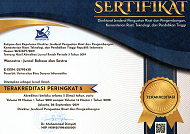Post-Traumatic Stress Disorder and Defense Mechanism in A Good Person Movie Directed by Zach Braff
Abstract
Full Text:
PDFReferences
American Psychiatric Association. (2013). Diagnostic and statistical manual of mental disorders: DSM-5 (5th ed.). America Psychiatric Publishing.
Ardesis, Y. (2022). Post-Traumatic Stress Disorder In The Stationery Shop Novel By Marjan Kamali. Journal of English Language Teaching and Learning (JELTL), 3(2), 33–44. http://jim.teknokrat.ac.id/index.php/english-language-teaching/index
Bordwell, D., & Thompson, K. (2008). Film Art: An Introduction. McGraw Hill.
Cohen, J. (2007). Interdisciplinary Psychoanalysis and the Education of Children. The Psychoanalytic Study of the Child, 62(1), 180–207. https://doi.org/10.1080/00797308.2007.11800789
COLLINS, M. (2022). MOVIE. In Casualty Reports (pp. 8–8). University of Pittsburgh Press. https://doi.org/10.2307/j.ctv2vr9c80.6
Cramer, P. (2006). Protecting the self: Defense mechanism in action. Guilford Press.
Creswell, J. W. (2013). Qualitative Inquiry and Research Design: Choosing Among Five Approaches (3rd ed.). SAGE Publications.
Flick, U. (2018). An introduction to qualitative research (6th ed.). SAGE Publication.
Freud, S. (1989). The Ego And The Id (1923). TACD Journal, 17(1), 5–22.
Gergen, K. J. (2015). An invitation to social construction (3rd ed.). SAGE Publications.
Herman, J. L. (1992). Complex PTSD: A syndrome in survivors of prolonged and repeated trauma. Journal of Traumatic Stress, 5(3), 377–391. https://doi.org/10.1002/jts.2490050305
Khendy. (2020). DEFENSE MECHANISM SYSTEM OF THE MAIN CHARACTER IN THE WHISPERING SKULL NOVEL: PSYCHOLOGICAL APPROACH THESIS.
Lazarus, R. S., & Folkman, S. (1984). Stress, Appraisal, and Coping. Springer Publishing Company.
Maryam, S. & R. H. U. & T. M. (2023). Psychoanalytic Interpretation of W.B. Yeats’ Dialogue of Self and Soul in relation to Id, Ego, and Super Ego. PAKISTAN LANGUAGES AND HUMANITIES REVIEW, 7(2), 437–447.
McFarlane, A. C. (2010). Post-Traumatic Stress Disorder: A Handbook for Clinicians (2nd ed.). CRC Press.
Mcleod, Dr. S. (2020). 10 Defense Mechanism: What Are They And How They Help Us Cope. Simply Psychology.
Mcleod Saul. (2024). Defense Mechanisms In Psychology Explained. Simply Psychology. simplypsychology.org/defense-mechanisms.html
Neelam, R. K. (2023). Types of PTSD. Charlie Heart.
Oatley, K. (2011). Such Stuff as Dreams. Wiley. https://doi.org/10.1002/9781119970910
Ressler, K. J., Berretta, S., Bolshakov, V. Y., & et al. (2022). Post-traumatic stess disorder: clinical and translational neuroscience from cells to circuits. Nature Reviews Neurology, 18, 273–288.
Rezeki, M. O., & Setyowati, R. (2023). Defense Mechanism of the Main Character of The Invisible Man Film. 7.
Silverman, D. (2016). Qualitative research (4th ed.). SAGE Publications.
Vaillant, G. E. (1992). Ego mechanism of defense: A guide for clinicians and researchers. American Psychiatric Association.
Van der Kolk, B. A. (2014). The Body Keeps The Score: Brain, Mind, and Body in the Healing of Trauma. Viking.
DOI: https://doi.org/10.31294/wanastra.v17i1.23891
Copyright (c) 2025 Rizqi Nabilla Yusdhodila Yahya, Unpris Yastanti, Wiruma Titian Adi, Lia Nurmalia

This work is licensed under a Creative Commons Attribution-ShareAlike 4.0 International License.
Index by:
Published by Department of Research and Community Service (LPPM) Universitas Bina Sarana Informatika by supported Relawan Jurnal Indonesia
Jl. Kramat Raya No.98, Kwitang, Kec. Senen, Jakarta Pusat, DKI Jakarta 10450

This work is licensed under a Creative Commons Attribution-ShareAlike 4.0 International License






